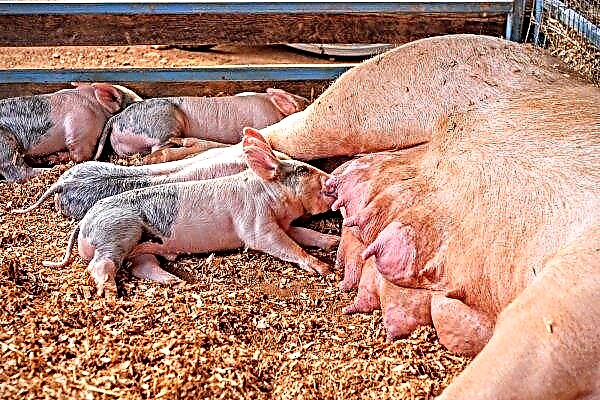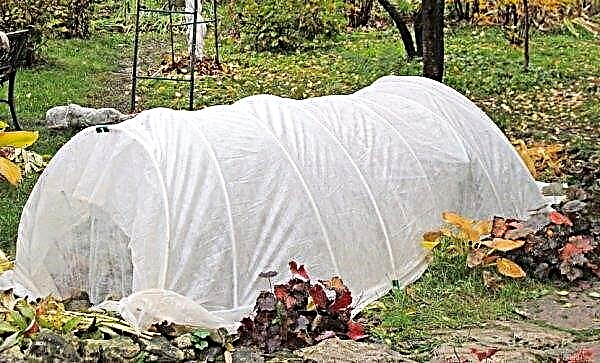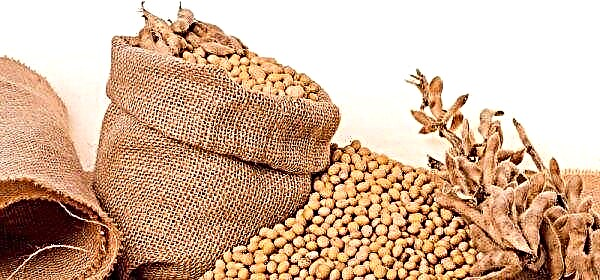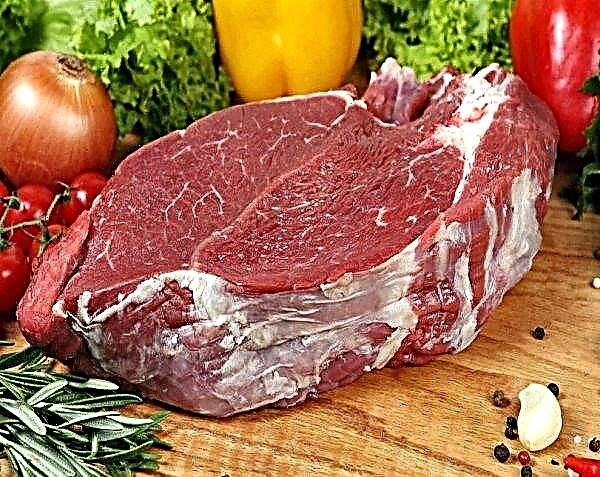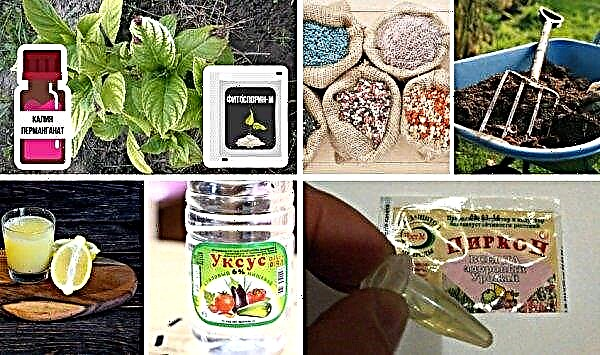Today, farming is again becoming popular, it is not only fashionable, but also profitable. For example, poultry farming can allow you to raise good capital over time, but even if you don’t have a desire to breed for sale, you can do this for yourself by providing your family and relatives with fresh, and most importantly, high-quality meat and eggs. Most often, breeding begins even with the appearance of chicks, this can be done using incubators. Let's get acquainted in detail with one of the most popular brands.
Total
The BI1 and BI2 incubators are used for home breeding of poultry and wild birds. The manufacturer is the Russian Federation, namely the company located in Novosibirsk.
The body is made of foam, due to which the design is not only lightweight, but also allows for good thermal insulation.Did you know? Despite the hard shell, the egg needs oxygen and fluid. It is known that in the 21 days during which the chicks hatch, the egg absorbs 4 liters of oxygen, removes 3 liters of carbon dioxide and 8 liters of steam. It does it through the pores.
 In addition, the device has:
In addition, the device has:- viewing window;
- capacity for liquid;
- evaporator;
- humidity sensor;
- thermometer (analog or digital).
All this provides the opportunity to configure the incubator to work as accurately as possible and at the same time save them in automatic mode. The device has the function of automatically turning eggs, which greatly facilitates life, as it eliminates the need to run to the incubator every 2-3 hours to turn the eggs. The minimum volume allows you to hold 36 eggs, and the maximum - 104.
Additionally, you can buy a battery, which in case of a power outage will ensure the operation of the device for about 20 hours. Today, incubators of the Layer are known to all poultry farmers, who note their reliability and quality. However, in addition to the fact that the device is fully automatic, it is very easy to use, and this makes it suitable for use even by beginners.Did you know? A chicken can carry eggs without a rooster, but there will be no yolk in them - the germ of the future chicken.

The lineup
In the lineup there are several varieties. All of them are easy to use, but at the same time they work on the same principle. The only difference is the size and, due to this, the capacity of the eggs.
Incubator Layer BI-1-36
| Working voltage | 220 V |
| Power | 28 watts |
| Temperature Accuracy | 0, 1 ºС |
| Operating temperature range | 33–45 ºС |
| Capacity | 36 pcs |
| Mass without eggs | 2.8 kg |
| Dimensions | 540 * 340 * 310 mm |

Incubator Layer BI-1-63
| Working voltage | 220-12 V |
| Power | 30 watts |
| Temperature Accuracy | 0.1 ºС |
| Operating temperature range | 33–45 ºС |
| Capacity | 63 chicken or 40 goose |
| Mass without eggs | 3.3 kg |
| Dimensions | 670 * 520 * 290 mm |
 Incubator Layer BI-2-77
Incubator Layer BI-2-77| Working voltage | 220-12 V |
| Power | 40 watts |
| Temperature Accuracy | 0.1 ºС |
| Operating temperature range | 33–45 ºС |
| Capacity | 77 chicken or 40 goose |
| Mass without eggs | 4.3 kg |
| Dimensions | 720 * 520 * 290 mm |

Incubator Layer BI-2-104
| Working voltage | 220-12 V |
| Power | 60 watts |
| Temperature Accuracy | 0.2 ºС |
| Operating temperature range | 33–45 ºС |
| Capacity | 104 chicken or 50 goose |
| Mass without eggs | 5.3 kg |
| Dimensions | 810 * 600 * 310 mm |
 All devices are designed for 10 years of trouble-free operation, but this does not mean at all that after this period the device will become unusable.
All devices are designed for 10 years of trouble-free operation, but this does not mean at all that after this period the device will become unusable.Advantages and disadvantages
Laying incubators have the following advantages compared to other analogues:
- pros
- affordability;
- ease of construction;
- good indicator of thermal insulation;
- ability to work on battery power;
- small dimensions;
- precise auto flip.
 In addition, the device, like other devices, has some disadvantages:
In addition, the device, like other devices, has some disadvantages:- Minuses
- fragility of the walls;
- inconvenience of potassium permanganate treatment;
- absorption of incubation odors.
Important! For cleaning, it is recommended to use abrasive cleaners, in addition, after the appearance of the chicks, everything needs to be disinfected.
User manual
We suggest that you familiarize yourself with the instructions for using the incubator, which includes a detailed description of all processes.
Preparatory process
Before laying it is recommended to carry out preparatory work, which consists of the following processes:
- Initially, they inspect and check the equipment.
- At the bottom lay the grate. It is important that the smooth side is facing up.
- Install the device for rotation on the body.
- The housing is covered with a lid.
- Connect the device to the network.
- Set the average temperature on the thermostat. The incubator will warm up for about half an hour, after reaching the set level, the indicator will begin to flash.
- Connect to a temperature regulator.
Owners of the incubator do not have the question of how to increase humidity, since the device has a water tank, which allows it to independently adjust this indicator.
Video: preparing an incubator for laying eggs
Egg laying
Eggs are placed only after pouring warm water and reaching a temperature of 37.7ºС. You can use a conventional thermometer to check the temperature. Only fresh eggs without contamination are selected for laying, it is strictly forbidden to wash them.
They should be medium in size, the shell is only a smooth matte shade. To store eggs, which will be further placed in the incubator, can be no more than 10 days at a temperature of at least 10 ° C.
Otherwise, all incubation qualities will decrease. To facilitate control when turning, it is recommended to put marks on the shell with a soft pencil, these can be ordinary numbers. After all the manipulations, the eggs are laid side by side next to each other.
Incubation Rules
On average, following all the recommendations, chicks appear 21 days after laying. To succeed in this, it is important to adhere to the following rules:
To succeed in this, it is important to adhere to the following rules:
- Constantly monitor the temperature inside the incubator.
- Do not forget to add water, after disconnecting the device from the power supply.
- Make sure that the rotary device does not fail, and the coup occurs at the specified time. In the first 5 days it is recommended to carry out these manipulations every 3 hours. Then no more than 2 times a day.
- Starting from day 5, it is recommended to ventilate the incubator. To prevent overheating of eggs.
- Swap eggs, performing these actions with a roll, so as not to damage the tissue of the embryo.
- Two days before the appearance of the chicks, a coup is prohibited.
- Throughout the entire period, 2 times control the development of eggs. This can be done using a conventional lamp. The first on 7, and the second on day 13.
- If there is no light, the incubator is transferred to a warm room and covered with dense material.
- After the first chicks appear, the temperature is lowered by 0.5 ºС.
- After hatching, the apparatus is washed well.
Hatching chicks
After the birth of the chicks, they are not sedimented from the incubator until completely dry. At this time, it is important to conduct an inspection to identify unhealthy chickens and not waste time and money on their further maintenance. Suitable young animals are selected according to the following indicators:
Suitable young animals are selected according to the following indicators:
- Umbilical cord. Ideally, it should be closed and free of blood.
- Fluff. Yellow, soft to the touch and shiny in appearance.
- Beak. Strong without anomalies.
- Eyes. No muddy spots with shine.
- Wings. Pressed tightly to the body.
- The chick should be mobile and responsive to surrounding sounds.
Important! The time of the initial examination depends on the subsequent direction of the hens: in eggs it is 6 hours after birth, and in meat 10 hours.
Which incubator is better: Cinderella or Layer
In general, these devices are quite similar, with proper use it is possible to achieve high hatchability of chicks. They have only a few differences. At Cinderella, switching to the backup source occurs automatically. Although, in this case, the second type of incubator can retain heat for a long time, and the owner can at any time identify the problem and connect it to the backup power. The second difference is that Layers have digital thermostats. And the final difference - in Cinderella, the heating elements are filled with water, acting as a buffer coolant. With their help, heating occurs gently without temperature jumps and with great uniformity of heating. In Layer, this function is performed by metal plates and a resistor. Based on the above information, everyone will choose the right one for himself.
The second difference is that Layers have digital thermostats. And the final difference - in Cinderella, the heating elements are filled with water, acting as a buffer coolant. With their help, heating occurs gently without temperature jumps and with great uniformity of heating. In Layer, this function is performed by metal plates and a resistor. Based on the above information, everyone will choose the right one for himself.
As you can see, the incubator Layer has every chance to obtain the status of an ideal adaptation for the removal of chicks in the budget segment. A large number of advantages negates the cons. By choosing it, you won’t have to regret the money spent.

